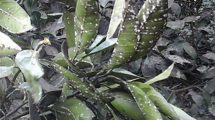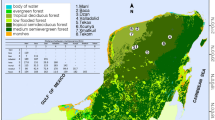Abstract
Hawthorn (Crataegus monogyna) is one of the natural hosts of Cacopsylla melanoneura, the acknowledged vector of ‘Candidatus Phytoplasma mali’, the causal agent of Apple Proliferation disease, a serious and growing problem for apple production in Europe, particularly in northern Italy. Wild plants could be important sources of both insects and phytoplasmas, but their role in the epidemiology of phytoplasma diseases and their insect vectors has never been thoroughly examined. Cacopsylla melanoneura’s primary host is hawthorn, a plant closely related to apple which often grows wild near orchards. Other psyllid species feed on hawthorn, but no data are available on their possible role as phytoplasma vectors. We investigated the hawthorn’s psyllid fauna in northwestern Italy using yellow sticky traps, beat trays, and molecular analyses from 2003–2005, to study the relationship between hawthorn, the phytoplasma and the insect vector. Population dynamics were monitored, and insects and hawthorn samples were analysed by polymerase chain reaction (PCR), restriction fragment length polymorphism (RFLP), and DNA sequencing for the presence of phytoplasmas. Cacopsylla melanoneura was the dominant psyllid species, followed by C. peregrina, C. affinis and C. crataegi. PCR and RFLP analyses revealed the presence of different fruit tree phytoplasmas in hawthorn plants, and in all four psyllid species.




Similar content being viewed by others
References
Ahrens, U., & Seemüller, E. (1992). Detection of DNA of plant pathogenic mycoplasmalike organism by a polymerase chain reaction that amplifies a sequence of the 16S rRNA gene. Phytopathology, 82, 828–832. doi:10.1094/Phyto-82–828.
Alma, A., Navone, P., Visentin, C., Arzone, A., & Bosco, D. (2000). Rilevamenti di fitoplasmi di “Apple proliferation” in Cacopsylla melanoneura (Förster) (Homoptera Psyllidae). Petria, 10, 141–142.
Altschul, S. F., Gish, W., Miller, W., Myers, E. W., & Lipman, D. J. (1990). Basic local alignment search tool. Journal of Molecular Biology, 215, 403–410.
Carraro, L., Loi, N., & Ermacora, P. (2001). Transmission characteristic of the European stone fruit yellows phytoplasma and its vector Cacopsylla pruni. European Journal of Plant Pathology, 107, 695–700. doi:10.1023/A:1011923801387.
Carraro, L., Loi, N., Ermacora, P., Gregoris, A., & Osler, R. (1998a). Transmission of pear decline by using naturally infected Cacopsylla pyri. Acta Horticulturae, 472, 665–668.
Carraro, L., Osler, R., Loi, N., Ermacora, P., & Refatti, E. (1998b). Transmission of European Stone Fruit Yellows phytoplasmas by Cacopsylla pruni. Journal of Plant Pathology, 80, 233–239.
Castresana, J. (2000). Selection of conserved blocks from multiple alignments for their use in phylogenetic analysis. Molecular Biology and Evolution, 17, 540–552.
Conci, C., Rapisarda, C., & Tamanini, L. (1992). Annotated catalogue of the Italian Psylloidea. First part (Insecta Homoptera). Atti dell’Accademia Roveretana degli Agiati 245, ser. VII, vol. II,B: 33–136.
Davies, D. L., Guise, C. M., Clark, M. F., & Adams, A. N. (1992). Parry’s disease of pears is similar to pear decline and is associated with micoplasma-like organisms transmitted by Cacopsylla pyricola. Plant Pathology, 41, 195–203. doi:10.1111/j.1365–3059.1992.tb02338.x.
Frisinghelli, C., Delaiti, L., Grando, M. S., Forti, D., & Vindimian, M. E. (2000). Cacopsylla costalis (Flor, 1861), as a Vector of Apple Proliferation in Trentino. Journal of Phytopathology, 148, 425–431. doi:10.1046/j.1439–0434.2000.00403.x.
Hodkinson, I. D., & White, I. M. (1979). Homoptera Psylloidea. Handbooks for the Identification of British Insects, Royal Entomological Society of London, 2(5), 1–98.
Jarausch, W., Lansac, M., & Dosba, F. (1999). Seasonal colonization pattern of European stone fruit yellows phytoplasmas in different Prunus species detected by specific PCR. Journal of Phytopathology, 147, 47–54.
Jarausch, B., Schwind, N., Jarausch, W., Krczal, G., Dickler, E., & Seemüller, E. (2003). First report of Cacopsylla picta as a vector of apple proliferation phytoplasma in Germany. Plant Disease, 87, 101. doi:10.1094/PDIS.2003.87.1.101A.
Lal, K. B. (1934). The biology of Scottish Psyllidae. Transactions of the Royal Society of London B, 82, 363–385.
Lauterer, P. (1999). Results of the investigations on Hemiptera in Moravia, made by the Moravian museum (Psylloidea 2). Acta Musei Moraviae (Scientiae biologicae). Brno, 84, 71–151.
Lemoine, J. (1991). Deperissement du poirier: role de Psylla pyri dans sa dissemination. Arboriculture Fruitière, 442, 28–32.
Lorenz, K. H., Schneider, B., Ahrens, U., & Seemüller, E. (1995). Detection of the Apple Proliferation and Pear Decline Phytoplasmas by PCR amplification of ribosomal and non ribosomal DNA. Phytopathology, 85, 771–776. doi:10.1094/Phyto-85–771.
Marzachì, C., Veratti, F., & Bosco, D. (1998). Direct PCR detection of phytoplasmas in experimentally infected insects. The Annals of Applied Biology, 133, 45–54. doi:10.1111/j.1744–7348.1998.tb05801.x.
Missonnier, J. (1956). Note sur la biologie du psylle de l’aubépine (Psylla peregrina Foerster). Annales des Épiphyties, 7, 253–262.
Ossiannilsson, F. (1992). The Psylloidea (Homoptera) of Fennoscandia and Denmark. In Fauna Entomologica Scandinava(vol. 26). Leiden: E.J. Brill.
Schneider, B., Seemüller, E., Smart, C. D., & Kirkpatrick, B. C. (1995). Phylogenetic classification of plant pathogenic mycoplasma-like organism or phytoplasmas. In S. Razin, & J. G. Tully (Eds.), Molecular and Diagnostic Procedures in Mycoplasmology (vol. I, (pp. 369–380)). San Diego: Academic.
Shaper, U., & Seemüller, E. (1982). Condition of the phloem and the persistence of mycoplasmalike organisms associated with Apple proliferation and Pear decline. Phytopathology, 72, 736–742.
Sutton, R. D. (1983). Seasonal color changes, sexual maturation and oviposition in Psylla peregrina (Homoptera: Psylloidea). Ecological Entomology, 8, 195–201. doi:10.1111/j.1365–2311.1983.tb00499.x.
Sutton, R. D. (1984). The effect of host plant flowering on the distribution and growth of hawthorn psyllids (Homoptera: Psylloidea). Journal of Animal Ecology, 53, 37–50. doi:10.2307/4340.
Swallow, W. H. (1985). Group testing for estimating infection rates and probabilities of disease transmission. Phytopathology, 75, 882–889.
Tedeschi, R., & Alma, A. (2004). Transmission of apple proliferation phytoplasma by Cacopsylla melanoneura (Homoptera: Psyllidae). Journal of Economic Entomology, 97(1), 8–13.
Tedeschi, R., Bosco, D., & Alma, A. (2002). Population dynamics of Cacopsylla melanoneura (Homoptera: Psyllidae), a vector of apple proliferation in northwestern Italy. Journal of Economic Entomology, 95(3), 544–551.
Tedeschi, R., Ferrato, V., Rossi, J., & Alma, A. (2006). Possibile phytoplasma transovarial transmission in the psyllids Cacopsylla melanoneura and Cacopsylla pruni. Plant Pathology, 55, 18–24. doi:10.1111/j.1365–3059.2005.01292.x.
Tedeschi, R., Visentin, C., Alma, A., & Bosco, D. (2003). Epidemiology of apple proliferation (AP) in northwestern Italy: evaluation of the frequency of AP-positive psyllids in naturally infected populations of Cacopsylla melanoneura (Homoptera Psyllidae). The Annals of Applied Biology, 142, 285–290. doi:10.1111/j.1744–7348.2003.tb00252.x.
Thompson, J. D., Gibson, T. J., Plewniak, F., Jeanmougin, F., & Higgins, D. G. (1997). The ClustalX windows interface: flexible strategies for multiple sequence alignment aided by quality analysis tools. Nucleic Acids Research, 24, 4876–4882. doi:10.1093/nar/25.24.4876.
Tomasi, F., Branz, A., Grando, M. S., Forno, F., Forti, D., & Vindimian, M. E. (2000). Individuazione di fitoplasmi del gruppo AP nelle psille presenti nei frutteti. Informatore Fitopatologico, 38, 51–54.
Van de Peer, Y., & De Wachter, R. (1994). TREECON for Windows: a software package for the construction and drawing of evolutionary trees for the Microsoft Windows environment. CABIOS, 10, 569–570.
Acknowledgements
The research was funded by the ‘Regione Valle d’Aosta’. We are grateful to Dr Luca Bertignono of the Institute Agricole Régional, Reg. La Rochère 1/A, 1100 Aosta –Italy for his help in field surveys. We thank Dr Maggie Sherriffs of the University of California for the English revision of the manuscript.
Author information
Authors and Affiliations
Corresponding author
Rights and permissions
About this article
Cite this article
Tedeschi, R., Lauterer, P., Brusetti, L. et al. Composition, abundance and phytoplasma infection in the hawthorn psyllid fauna of northwestern Italy. Eur J Plant Pathol 123, 301–310 (2009). https://doi.org/10.1007/s10658-008-9367-1
Received:
Accepted:
Published:
Issue Date:
DOI: https://doi.org/10.1007/s10658-008-9367-1




